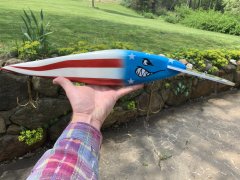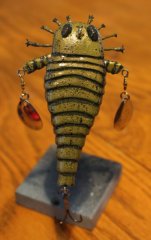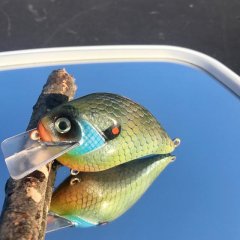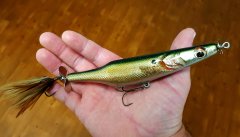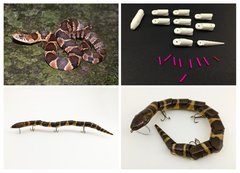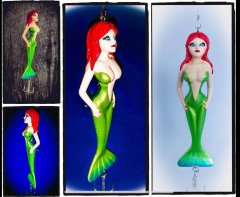-
Posts
906 -
Joined
-
Last visited
-
Days Won
45
Content Type
Profiles
Articles
TU Classifieds
Glossary
Website Links
Forums
Gallery
Store
Everything posted by Chuck Young
-
Have you tried nail art foil? It is used in hair and nail salons to adorn women's fingernails. It is an ultra thin layer of shiny material applied to the thin plastic backing. After being glued, the plastic film is removed. The material I use is 4 cm wide and comes in 120 meter long rolls. Many colors are available: silver (shinier than aluminum), holographic silver, and holographic clear are most useful. Gold is also useful for a few patterns. The cost is much more reasonable than you might think. You can use m77 to apply it. However, I prefer to use thin epoxy like E tex or Devcon 2T thinned with a little denatured alcohol added to either of them. The key is to apply the right amount of epoxy; You should be able to feel the scale texture as you remove the excess with your finger. Use 4 layers of 1/4" craft foam (Michael's) on each side of the lure. Add a board to the top, and compress gradually with C- clamps. When the left over epoxy is cured, release the clamps and remove the plastic. I did a tutorial on this site earlier using heat transfer foil. Look it up. Many of the finer points still apply. This updates that process a little. http://www.tackleunderground.com/community/topic/34741-using-heat-transfer-foil-to-chrome-no-machine/
-
I think the horizontal line tie may act like a pivot point to enhance side to side action. Many swivels and clips come to a point, which would inhibit the action on a vertical line tie.
-
Thanks Mark. That sounds like the way to go.
-
Microwave motors are great for this. They seem pretty durable as well. I have a turner design in the homebrew tools section. I have a section of pvc pipe going through a 3 ft section of swim noodle. Lure holders can be inserted into the foam. Mine regularly turns 8 to 10 1-1/2 oz lures at a time.
-
As I was reading the earlier posts (before the last picture was posted) I was wondering if going to a single hinge point instead of a dual one would enhance the action. I have fished a ton of soft baits with boot tails. The tail doesn't just go side to side. It pitches up and down and rolls as well. I think the tail section should be shorter than the head section.
-
I want to apply GID powders with my airbrush. My plan is to mix them into Createx transparent base. To date, I have been applying a thin epoxy layer and dusting the lure with powder. I want to get away from handling the powder. I have a fan spray booth and a theory that wet powder is less likely to fly than dry powder. The Techno Glow white powder that I am considering is 35 microns and is supposed to glow for 10 hours when fully charged. The add says it can be sprayed through a tip .35 in or smaller. I suspect that is a typo on their part. That is what I gap my spark plugs to! Plus I beg to ask "how much smaller?" This is a completely useless piece of info. So, my friends, I turn to you. What are your recommendations, experiences, and concerns.
-
As a filler, you can mix micro balloons with epoxy. It sands well.
-
I use nail art foil and apply it under pressure with thin epoxy. This foil is available online in 120 meter lengths in a variety of colors. The plastic film is very thin. It conforms well to scale detail. The film backing is then removed, leaving a very thin reflective surface. I have a tutorial on this site. It is a good place to start. With nail art foil, you do not have to use the heat gun and vacuum as shown there. As for painting, foil is a slick surface. I apply one or 2 coats of Createx Transparent base before I apply colors. The T base is creamy white, but heat sets perfectly clear. You have a hard time messing up your paint job this way. It can be done, but you really have to work at it to "chip off" any color.
-
-
- 1 comment
-
- eurypterid remipes
- now for something new
- (and 3 more)
-
-
Changing to a lighter or heavier wood won't do anything other than change the amount of lead you need to add. The overall weight of the lure will not change, since the problem is density. The only way to change the weight of the lure is to change the displacement of the lure by reducing thickness, height, or length. Another possibility is to add a chamber that can flood with water and drain before casting. The chamber should be in the rotational center of the lures action, since fluid acts as a dampener to action.
-

Why does everyone paint now? Literally everyone
Chuck Young replied to bassmaster0726's topic in Hard Baits
Painting a dozen or so patterns on a few different blanks is not my idea of custom paint. I am currently working on a site that offers thousands of variations. None of the baits will be pre-painted. -
I cut mine in the square also. I made a small plywood miter box for this lip slots. But instead of the angles going at vertical angles, I do a horizontal cut. Just cut the slot(s) on a table saw. An alternative to the band saw is to glue some hacksaw blades together. It is just about right for 1/8' lexan. http://www.tackleunderground.com/community/topic/31732-lip-slot-jig/
- 11 replies
-
- 1
-

-
- crankbait
- crankbait lip slot
- (and 7 more)
-
I had a similar problem when I started painting. Clean blank, gloves, priming (either O white or clear base for ghost) very thin coats should solve the problem. Now I only spray with a fine head / needle assy often below 10 psi. These thin coats will preserve any surface details like scales and gills. It takes 3 seconds or less to cure a coat with a hair dryer set on high. I never used Dick Lites, but found that a few lures had the MCU soak beneath the paint and wrinkle it. Now I use 2 coats of E-tex.
-
I have made a few of this type of lure. I can confirm all your observations about flat bottom, center of gravity - longitudinal, higher center of gravity, rate of sink. I will add that the shorter the height and flatter the sides, the faster it wobbles. Also rounding the sides slightly slows the wobble. To help with the high COG, I run the wire for hangers along the top of the lure. I have a bass tree in my front yard, and find it perfect for this type of lure,
-

20180616_201808.jpg
Chuck Young commented on Brandon Seutter's gallery image in Best Homemade Hardbait
-

NorthernWaterSnakeLure.jpg
Chuck Young commented on sthone's gallery image in Best Homemade Hardbait
-

D09235B7-06B6-446D-BC35-8EE7D0327BC3.jpeg
Chuck Young commented on Blackeye's gallery image in Best Homemade Hardbait
-
I enjoy conceiving, designing, carving and painting new baits. I have worked with balsa, Basswood (I have a tree in my front yard), birch and cedar. Eventually, I will branch out into this area and get a bandsaw, mini lathe, belt sander, etc. For now, I have decided to focus mainly on painting.
-
I use the wider 3/8 to 5/8" artist brushes found at wallyworld. But I modify them with a pair of scissors - so they remain as wide, but with fewer bristles. This gives them just the right flex for even coverage and reduces the amount of resin the absorb. Cleaning the brush is easy. Swirl brush in a little denatured alcohol in a mixing cup - paper towel brush. Pour DNA over brush. Wrap in paper towel. A microwave rotor motor works well for a lure turner.
-
I agree that many items from the fabric store will work. Some of these materials look different when stretched out over a bait. As will the plastic mesh loofa material - which also comes in multiple sizes.
-
Ditto with Mark on the E-Tex epoxy. It also is clearer than Devcon. The two part marine paints are self leveling - and will destroy any scale detail.
-
I have been using my badger 150 bottom feed with a fine head and needle for a long time. It has produced some very fine work. Eventually I will upgrade to the Iwata HPC and run both - using the Iwata for finer details. Spraying water from the Badger shoud be a great way to clean the cup on the Iwata.



